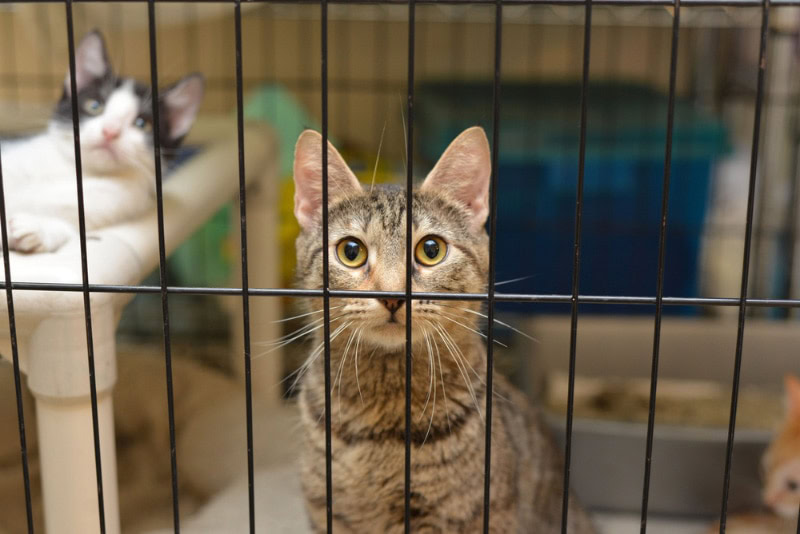VET APPROVED

The information is current and up-to-date in accordance with the latest veterinarian research.
Learn more »Click to Skip Ahead
Feral cats are usually born outdoors and are fearful of people because they have not been socialized with humans. These cats are wild animals and can be tamed at times, but it requires plenty of patience and time. Most animal lovers who encounter feral cats wonder if they can take them home and care for them. However, it is not as easy as it sounds.
There are some steps you need to take to tame an adult feral cat. This article will educate you on those steps.

Feral Adults vs Kittens
Feral kittens under 12 weeks of age are easier to tame than adult ferals if they are captured early enough before they learn to survive by themselves in the wild with no human contact. The older the kitten gets, the harder it becomes to tame them. Feral moms give birth to their kittens in hidden, quiet places to keep them away from humans. Once the kitten grows older and starts playing around, humans notice them, but are not easy to capture.
Kittens should not be taken from the mother before they have spent enough time with her. They need to be fed by their mom for at least five weeks and most kittens are fully weaned by six to eight weeks. If a feral kitten is to be tamed, the best time to start this process is between 5 and 11 weeks of age. You should also consider capturing their mother and getting them spayed to prevent future litter. This process is called Trap-Neuter-Return (TNR). Different cats have different temperaments. Hence, taming a feral kitten is not like clockwork. Kittens from the same litter can also differ in personality. It, therefore, requires a lot of patience to tame a feral cat.


The 7 Tips for Taming a Feral Cat
1. Call Your Local Animal Control
If you notice a lone cat lurking around your neighborhood, you should never make contact with them. A feral cat considers humans as threats, and when afraid, they can bite, hiss, or even attack you.
Sometimes, feral cats might seem sick, and even if you would like to help them, you shouldn’t. A feral cat could have rabies, and it’s safer if you call your local animal control to avoid being bitten or scratched by them.
Once the cat is known to be in good health, you can now start the taming process. The process can take several weeks, depending on the cat.

2. Let the Cat Initiate Contact
When looking to tame a feral cat, you should never force an interaction. Let the cat go about their business as usual.
If you want the cat to hang around you more often and become interested in you, feed them, and stay in the area without giving any specific attention to them. When you notice they keep hanging around you, you can continue interacting with them.
3. Offer the Cat Food
Once the cat seems to be comfortable around you, you can start feeding them in a non-threatening way. You must make sure that the cat tolerates interacting with you. The best time to initiate contact with the cat is during meal times.
One of the best ways to do that is by offering food to the cat. So, the best time to initiate contact with the cat is during meal times.
Offer food to the cat at the same time every day. You can pick a specific place to put the food where the cat can find it to build a routine.
You will notice that the cat will keep coming back for food every time. Keep a close distance from the cat when they feed, but do not touch them at first.
You can also offer the cat treats, making the cat want to spend more time with you alone.

4. Desensitize the Cat to Human Contact
Human contact can be scary for most cats. This includes being touched, sounds of other people talking, opening doors, and music. All these sounds can leave the cat on edge.
You must make sure that the cat gets used to these sounds to no longer be scary and distracting. This might take a while, but you can introduce the sounds to them slowly as you interact with them.
5. Do Not Touch or Pick Up the Cat Until It Is Ready
It would be best if you took cues from the cat from its reaction. If you get close to the cat and they back off, then you need to back off as well.
Getting the cat comfortable around you is a very slow process, but it is worthwhile. However, always be prepared for occasional setbacks to avoid disappointments.
If you move too quickly and the cat is not ready, they might be defensive. They might scratch or bite you if they feel the need to protect themselves.

6. Invite the Cat Inside
Once the cat is used to having regular interaction with you, you can now invite the cat to your space. The cat will only accept the invitation if they are comfortable with all the human sounds and no longer scares them.
You can invite them inside by leaving your door open for them after interacting with them. You can also leave the food and water at your door and slowly get the cat used to the idea of getting into your home.
7. Provide Essentials and Create a Welcoming Space
Once the cat becomes comfortable enough to enter your home, it’s crucial to ensure they have everything they need to feel safe and secure. Set up a dedicated area with essentials such as food, water, a litterbox, perches, toys, puzzle feeders, a cozy bed, and hiding spots. This space will give the cat a sense of security while they adjust to their new surroundings.
While having a designated area is helpful, avoid confining the cat to a single space. Allow them the freedom to explore and adapt at their own pace. Building trust takes time, and giving the cat room to move around while providing consistent care and gentle interaction will help them settle in and feel at home.


Final Thoughts
Before you decide to try to tame a feral cat, make sure they do not belong to someone who might be looking for their cat. If you are sure it is a feral cat, you must ensure they are a good candidate for training.
Feral cats are wild and not socialized with humans, making the process very difficult and sometimes, impossible. If you want to try, don’t force interactions and let them take the initiative. Over time, you may end up building your relationship and invite the cat to your home.
See Also:
Featured Image Credit: dimitrisvetsikas1969, Pixabay











